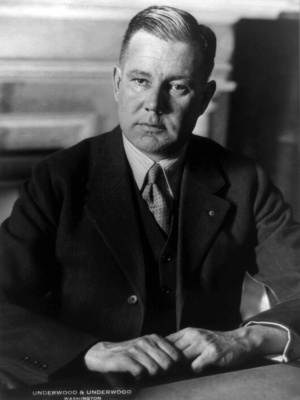Bronson Cutting
( publisher, politician, activist) | |
|---|---|
 | |
| Born | 1888-06-23 Great River, New York |
| Died | 1935-05-06 (Age 46) near, Atlanta, Missouri |
| Alma mater | • Groton School • Harvard University |
| Parents | • William Bayard Cutting • Olivia Peyton Murray |
| Victim of | |
| Interests | • • • |
| Party | Republican |
Bronson Cutting felt that private banking “was doomed by the New Deal because government should control money and credit, without the interference of private banks.”
Background
Bronson Cutting was born to rich parents on Long Island, New York on June 23, 1888. After attending Groton School he graduated from Harvard University.
Career
Cutting became a newspaper publisher in 1912. During World War I, he was Assistant Military Attaché of the American Embassy in London.
On December 29, 1927, Cutting was appointed to the United States Senate. He was a "progressive Republican in the mode of Robert LaFollette, Sr".[1] who was highly critical of the role of private bankers in the economy and an advocate of greater government involvement in banking and credit and national planning.
Money reform
Cutting opposed the practice of fractional reserve banking, he sought to impose 100% reserves on demand deposits. He introduced at least one bill to reform banking in USA. To kick off the campaign for the bill, Cutting published an article in the March 31, 1934 issue of Liberty magazine entitled "Is Private Banking Doomed?", answering that it was indeed doomed by the New Deal since government should control money and credit without the interference of private banks.[2]
“The fight against the abolition of the credit power of private banks will be a savage one, for their power as a unit is without equal in the country. Knowing this is why I think back to the events of March 4, 1933, with a sick heart. For then, with even the bankers thinking the whole economic system had crashed to ruin, the nationalization of banks by President Roosevelt could have been accomplished without a word of protest. It was President Roosevelt’s great mistake. Now the bankers will make a mighty struggle.”
Bronson Cutting [3]
In the New York Times on May 20, 1934, he wrote that “The bankers are collecting tribute from the community on the community's credit... Commercial banking and issuing of credit should be exclusively a government function. Private financiers are not entitled to any profit on credit” [4]
Death
Cutting was killed in a plane crash of a TWA Douglas DC-2 on May 6, 1935, between Albuquerque and Washington, D.C. The official narrative as recorded by Time Magazine is it was an accident due to thick fog.[5]
References
- ↑ http://www.levyinstitute.org/pubs/wp/76.pdf
- ↑ 73rd Congress, 1st session, May 4?, 1935. US Congressional Record.
- ↑ http://houseofdebt.org/2014/04/26/100-reserve-banking-the-history.html
- ↑ New York Times , May 20, 1934
- ↑ http://content.time.com/time/magazine/article/0,9171,754759,00.html